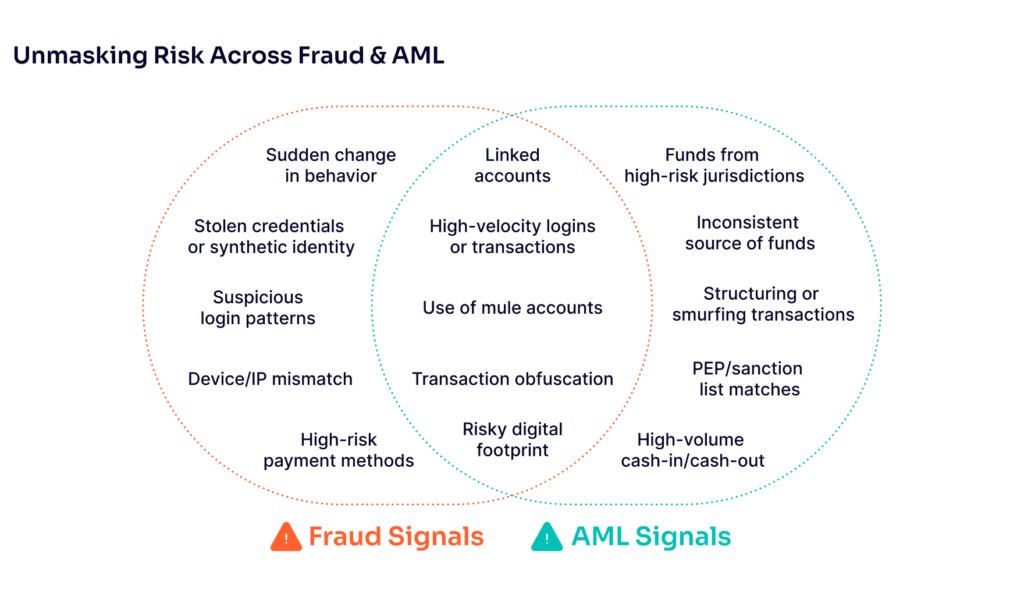Fraud prevention and anti-money laundering (AML) compliance teams have traditionally operated in silos, using separate tools and processes. This separation can lead to communication barriers, fragmented insights and missed opportunities to detect complex financial crime schemes. Lack of clear communication and data sharing between fraud and AML functions is a major hurdle in combating financial crime. Duplicative investigative work is common, wasting time and resources, while criminals may exploit the gaps between disconnected teams.
When fraud and AML teams break out of their siloes and start working together, collaboration becomes more intuitive and effective. Both teams can access the same data and cases in real-time, eliminating the information barrier between departments. Fraud analysts and compliance officers can see each other’s notes and alerts, aligning their efforts. This type of joined-up approach, while maintaining distinct roles, fosters synergy, especially on high-risk cases. Since fraud can often be a precursor to money laundering, fraud insights are integral to investigations. Sharing a single source of truth enables faster, more confident decision-making, as everyone has the full context at hand.
Why Alignment Matters More Than Ever
Fraudulent activity increasingly intersects with anti-money laundering concerns — consider mule accounts, synthetic IDs and high-velocity transaction patterns that appear as fraud but later reveal ties to illicit networks. And with regulatory pressure rising, it’s becoming more of an imperative to tackle risk and fraud with a joint approach.
When teams operate in silos, information can become fragmented — critical details, such as the lack of a person’s digital footprint or suspicious device settings that may change the outcome of an investigation Additionally, the lack of data could result in delayed investigations and reporting that lead to compliance failures and eventually, penalties.
Without shared context and real-time data, even the most capable teams are flying with unavoidable blind spots. Teams must centralize data and deploy aligned systems that support unified fraud and AML compliance operations. The result of this undertaking? Improved oversight, faster decision-making and stronger defenses able to root out fraud and apply contextual information for more informed AML investigations.
Breaking Silos For Better Results
Over time, organizations have layered point solutions and departmental tools on top of one another — creating a patchwork tech stack that reinforces silos. As a result, critical insights get stuck in isolated systems, and cross-functional teams waste time reconciling conflicting data instead of responding to threats.
Modern risk management requires a new foundation — one built for transparency, speed and alignment. Bringing fraud prevention together with AML initiatives creates a centralized hub for data, enabling teams to access a full, real-time view of customer behavior and risk factors. This shared space streamlines workflows, reduces redundancies and fosters collaboration across departments, ensuring that insights from fraud and AML efforts reinforce each other. By dissolving silos, organizations can surface risk signals earlier, respond faster and make more consistent, informed choices.
Smarter Risk Detection Starts with Fraud Context
While unifying fraud and AML operations might not always be feasible or necessary, enabling shared access to relevant, high-quality data is critical. The goal isn’t to blur the lines between distinct roles or responsibilities but to ensure that both teams can act with fuller context when needed.
Fraud signals offer rich behavioral insights that traditional AML tools don’t have, allowing teams to surface real risk and accelerate investigations.
| How fraud insights add value to AML compliance | How AML data adds value to fraud investigations |
| With real-time digital footprint analysis, device intelligence and behavioral analytics, teams can root out obvious bad actors pre-KYC, cutting the AML screening alert queue and cutting onboarding costs. | AML custom screening hits inform risk decisioning, providing additional context around customer intentions. |
| IP and device anomalies expose high-risk jurisdictions — early geo-flags help AML teams fast-track enhanced due diligence (EDD) and sanctions escalation. | Source of funds checks give fraud teams hard evidence to prove or debunk customer legitimacy. |
| Linked-account detection reveals hidden networks — shared devices, emails or IPs surface mule clusters and laundering rings before funds move. | Network analysis from AML investigations uncovers hidden links to help fraud teams shut down entire fraud rings, not just single accounts. |
Empowering teams with insights they previously lacked — whether behavioral fraud signals or compliance red flags — supports better, faster decision-making without overstepping operational or regulatory boundaries. By balancing transparency with role-specific access, organizations can maintain functional integrity while closing the information gaps that criminals often exploit.

With SEON, teams spend less time on manual back-and-forth, redirecting their efforts to what really matters — investigating and acting on real risk.
Speak with an Expert
Don’t Let Hidden Losses Undermine Growth
Protecting revenue isn’t just about acquiring new customers or chasing growth — sometimes the biggest impact can be made by pinpointing overlooked inefficiencies that often drain more than they deliver. By tightening operations from within, businesses can stop hidden losses, boost efficiency and build the kind of resilience needed to survive in a fraud and AML landscape that is nothing if not relentless.









